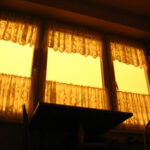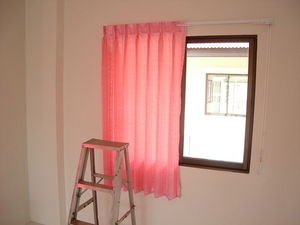Formal bed coronets look impressive yet are simply lined curtains suspended from a special shaped track fitted above the bed.
An attractive coronet of fabric that sits high above the bed and sweeps down in graceful folds turns a plain bedroom into a romantic haven. The coronet can be as simple as an ordinary pair of curtains, or become a more elaborate affair with the addition of a frilled and piped valance.
Any fabric that can be used in curtain making is suitable for bed coronets, so you can choose to mix or match with the window treatment. The back curtain and lining of the side curtains can blend or contrast with the main curtaining; try a smaller print, or a plain or striped fabric, to complete the look.
A coronet shelf is a completely invisible way of hanging simple curtains symmetrically over an ornamental bed head. If the bed is pushed up against a wall, two coronet curtains provide an effective frame when draped over the head and foot ends.
The following instructions show how to make a coronet based on a kit track with curtains to frame a standard double bed. The kit comes complete with brackets for putting up the track, which is fitted with gliders to carry the curtain hooks.
The valance is fitted to the top of the track, in front of the curtains, with special valance hooks. If you have trouble finding a suitable kit, I will leave you with instructions for making a coronet shelf from inexpensive board.
These coronet drapes consist of three separate curtains; two side curtains and a back curtain. The side ones need to be lined, but to save cost, the back curtain can be made of lining fabric alone, to match the lining of the curtains. The valance, which is just a very short curtain, is made separately. Her it is lined, with a frill inserted between the lining and the main fabric.
The headings on the coronet curtains and valance need to be gathered up with a heading tape. Standard gathered tape is used here, but any style is suitable. On the valance the tape is positioned to form a frilled heading.
Look for coronet kits and curtain fittings in the soft furnishing areas of department stores.
To make the formal canopy bed hanging you will need:
Coronet track
Two tieback hooks
Fabric for side curtains and valance
Lining for curtains and valance
Plain fabric for covering piping cord
Thread, heading tape, curtain hooks
Valance clips
Preparation and measuring up
1. Fixing up the track: Mark the height of the coronet above the bed. Coronets are often placed 7 feet (220cm) above a bed. Following maker’s instructions, fix the track at the marked point. Fit a tieback hook on each side of the bed.
2. Measuring back curtain: Allow one standard 48 inches (122cm) width of lining fabric for the back curtain. For the length, measure from the back of the track to the floor and add 2 5/8 inches (6.5cm) for the hem and heading.
3. Measuring for the side curtains: To work out the length of the side curtains, tie string to the track and drape it down behind the tieback hook to the floor. Note the length and add 1 1/4 inches (3cm) for the hem and heading. Each side curtain is made up of one and a half fabric widths, so allow three times the final length. Allow for the same amount of lining.
4. Measuring a valance: Measure from the track to the chosen length. Valances are usually between 12-20 inches (30-50cm) deep. Deduct the depth of the frilled edge and then add 8 inches (20cm) for the hem and heading frill. Allow for two fabric widths, and an extra 12 inches (30cm) for the frill. Allow one curtain length in a plain fabric for binding the leading edges of the side curtains and covering piping cord on the valance.
Sewing the curtains and valance
1. Making the back curtain: Turn under a double 3/8 inch (1cm) hem down both sides; pin and machine stitch. Turn up a double 1 inch (2.5cm) base hem; pin and machine stitch. Turn down top edge for 5/8 inch (1.5cm) and stitch heading tape to cover raw edge. Gather the tape so it is taut across the back of the track. Secure with a ho0k at each end of the tape slotted into the end stops.
2. Cutting out the side curtain: Cut out three fabric widths to the final length from step 3, Preparation. Fold one width in half lengthways matching selvedges. Carefully cut down the fold. Pin and machine stitch one half width to the outside edges of both full widths to form each curtain. Repeat to make two lining panels of the same size.
3. Making the side curtains: To insert binding along the curtain front edge, cut plain fabric to the curtain length, by 3 1/4 inch (8cm) wide. Fold in half with wrong sides together, matching raw edges. Position to the right side of the main curtain fabric, matching raw edges. Place lining to the main fabric with right sides together. Pin, tack and machine stitch the side and base edges taking 5/8 inch (1.5cm) seams. Trim and turn the right side out. Repeat with the second curtain.
4. Forming top heading: Treating main fabric and lining as one, turn down the top edge for 5/8 inch (1.5cm). Stitch heading tape to cover the raw edges. Gather tape so each curtain fits half of the track. Put hooks into the heading tape and hang curtains on gliders to meet in the center front.
5. Cutting out valance: Cut fabric and lining to measurements from step 4, Preparation. For frill, measure hem edge and allow 1 1/2 times length. Decide on the frill depth. About 2 1/4 inches (6cm) adding 1 1/4 inches (3.5cm) for hem and seams.
6. Inserting the piping: Cut a length of piping cord the same length as the valance hem and cover with plain contrasting fabric. Neaten ends of piping. Tack firmly along the base edge of the valance with the cord facing inward and raw edges together.
7. Gathering the frill: Turn under a double 3/8 inch (1cm) hem along the base and sides of the frill; pin and machine stitch. Work two rows of gathering stitches along the top of the frill. Pin at intervals to the valance hem over piping, gathering up evenly to fit, and tack. Place the lining to the valance with right sides together. Pin and stitch edges and hem together. Trim and turn right side out.
8. Hanging the valance: Treating the main fabric and lining as one, turn back 3 1/4 inch (8cm) hem on top edge of valance and tack. Position the heading tape so that it covers the raw edges and stitch it in place. Gather up the heading to fit the track and use the valance clips to hang the valance in front of the side curtains.
Making a coronet shelf
Without a specialist track you will need to make a coronet shelf from blockboard and fix it above the bed on angle brackets. In this case, two-side curtains are simply held in place on the shelf by Press ‘n Drape heading tape against Grip tape, available from haberdashery departments. To estimate the amount of fabric and lining you need, follow step 3, Preparation and Measuring up. Allow extra to cover the shelf.
You will need:
3/4 inch (20mm) thick blockboard measuring 20 x 12 inches (50 x 30 cm)
Two metal angle brackets with screws and wallplugs
String, nail, hammer, pencil
Jigsaw, sandpaper
Curtain fabric, 20 x 13 3/4 inches (50 x 35cm)
Staple gun and staples
Press ‘n Drape tape and Grip tape
1. Cutting out the coronet shelf: Hammer a nail into the center of one long edge of the board. Tie one end of the string around the nail and the other around the pencil so that when the string is taut is measures 8 3/4 inches (22cm). Keeping the string taut, draw a semicircle, the using the jigsaw, cut out the shelf. Sand the edges smooth. Screw the angle brackets to the underside of the shelf.
2. Covering the coronet shelf: Lay the blockboard on the wrong side of the fabric and mark round. Cut out, adding 1 1/2 inches (4cm) all round. Wrap the fabric edges over the top of the coronet shelf, snipping into fabric so it will like flat and sit round the brackets; staple the edges down.
3. Fixing the Grip tape: Stick the self-adhesive Grip tape round the curved front edge of the coronet shelf to hold the curtains when the Press ‘n Drape heading tape is pushed against it. Using wallplugs and screws, fix the coronet shelf securely to the wall.
4. Making side curtains: Make up each side curtain as given in the previous instructions, but in place of standard tape, stitch on Press ‘n Drape heading tape. Hand stitch the center front leading edges of the curtains together for 4 inches (10cm). Pull up the heading tape evenly on the curtains and press in place over the tape round the edge of the coronet shelf.
Adding a valance
To add a valance using this method, insert screw eyes into the underside of the shelf. Make the side curtains with standard heading tape and hang them up using curtain hooks passed through the screw eyes. Attach the valance to the edge of the shelf with Press ‘n Drape tape.
Inserting screw eyes: Drive the screw eyes into the underside of the blockboard round the curved edge, spacing them approximately 2 1/2 inches (6cm) apart.




